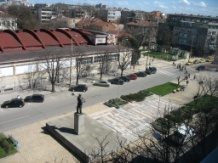

The monument of Stefan Karadzha is a sculptural figure, cast in bronze, sitting down on a square granite pedestal, around which were carved reliefs of scenes from the glorious struggles of the Bulgarian people against the oppressors. It was built in 1976, 100 years after the death of St. Karadzha. The author of the architectonic art. B. Petrov and sculpture and reliefs – N. Terziev G. et Radulov. Monument of Stefan Karadzha Ruse This monument was erected in the village of birth of the great Bulgarian Stefan, Karadzhovo Yambolsko today.
Stefan Karadzha was born on May 11, 1840 in the village Ichme (today Stefan Karadzhovo), Yambol. His father, Todor Dimov, is the grandson of the great Nikola Uzun, who died in 1817. Uzun Niko is one of the instigators of the Good Strandzhanska 1810, which led to the devastation of the rich Turkish village, Karaevren (today Bliznak) of Strandzha. Because of material reasons, his family moved in 1844 near Dyukmen village (today Leyarovo), Yambol, in 1847, moved in Ludogorieto and in April 1847 were settled in Northern Dobrogea, relatives moved after the Russo-Turkish War of 1828-1829.
For a time, Karadzha also taught the craft of shoe to his son-Nikola Stanchev. He learned in Tulcea, but due to lack of means, has left school. During the wedding on the famous Turkish wrestler Gaazi corrugation. It hid for a while, followed by the Turks, after which he emigrated to Romania in 1862. Since then started the revolutionary activity.
Stefan Karadzha was one of the first volunteer organization in Rakovski, First Bulgarian Legion in Belgrade. It has manifested against the Turks in Belgrade. After dissolving the legion, Stefan Kardzhali was returned to Romania, where he dedicated entirely to the national struggle. Several times he crossed the Danube with revolutionary tasks. In 1866, for the first time joined a small bands led by Hadzhi Dimitar and brave Zhellyo, which crossed on the right bank of the Danube. In 1867, he joined the Second Bulgarian Legion. In 1868 he left and came back in Romania where, again met with Hadzhi Dimitar. On 6 July the two led a detachment of 127 people which crossed the Danube to the village VARIMAT. In the battle of Kanlatere place, at the edge of Vishovgrad, Stefan Karadzha was badly injured and captured by the President of the National Council envoys, Midhad Pasha, army and police. Then, on July 12, he was taken to Tarnovo and later to Russia. Half dead, was sent before the tribunal set up in Midhad extrordinar Pasha, the council called him criminal, and was sentenced to death by hanging. On July 30, 1868, he died from injuries in the Russian prison. He was buried in Baba Tonka. Until today, his skull is kept in the house-museum “Baba Tonka” in Russian. The original stone tomb of Stefan Karadzha was found in the construction of the house-museum of Baba Tonka in January 2014. Despite all the historical references are deemed Stefan Karadzha died on July 31, 1868, according document from the cross, he died a day earlier – on July 30, 1868.
